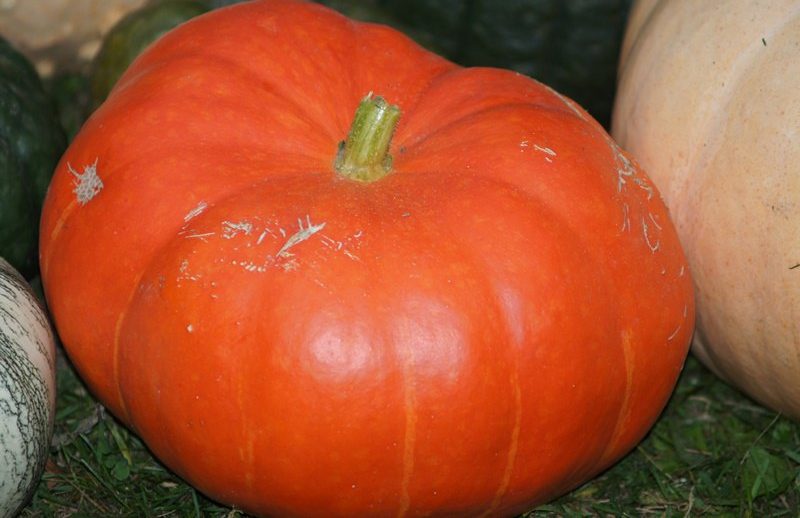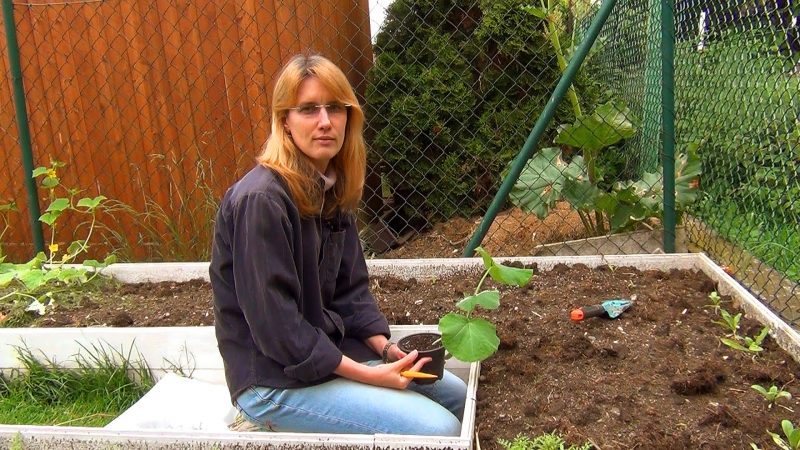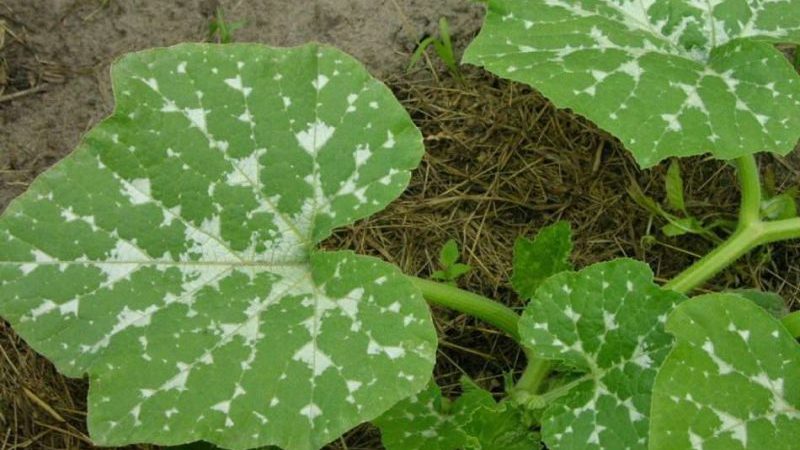Pumpkin variety "Melon", adored by gardeners for its sweet taste and extraordinary aroma
Pumpkin is considered to be one of the healthiest and most nutritious vegetable crops. It contains a large number of trace elements that have a positive effect on the state of the whole organism. Thanks to this, the vegetable is recommended for baby and diet food. In application, pumpkin is universal: it is suitable both for savory second courses and for sweet desserts and juices.
In the countries of the former CIS, pumpkin is grown everywhere. It takes root well in our climate and is distinguished by its unpretentious care. Melnaya pumpkin is popular among the abundance of varieties of melons and gourds. Why she got such a name and what secrets of her agricultural technology exist, read on.
The content of the article
General description of the variety
Melon pumpkin is a large-fruited hard-bore variety bred by Russian breeders. It was included in the State Register in 2006.
The agrofirm "Poisk" is considered the originator of the variety. The seeds are produced by several manufacturers.

Distinctive features
The vegetable has a large size. The weight of one fruit with proper agricultural technology can reach 30 kg.
The variety refers not only to large-fruited: it is listed in the register as hard-bore. The thick shell allows the fruit to be stored for more than 1 year.
Melonnaya differs from other pumpkin varieties with similar characteristics by an unusual taste. It is sweet and juicy with a distinct melon aroma. The pulp is firm. It retains its shape during heat treatment.
The composition of this representative of melons contains an increased amount of beta-carotene, vitamins B, C and A, fiber, sodium and magnesium. Valuable substances have a positive effect on the condition of the liver, skin, intestines, stomach, strengthen the immune system. Melon is suitable for dietary and baby food.
Unlike many other varieties, this vegetable is not afraid of low temperatures - it can withstand a cold snap up to +2 ° C. Cultivation is possible in the Urals and Siberia.
Main characteristics
Description of Melon pumpkin will delight both beginners and experienced gardeners. The variety is easy to grow in any region of our country.
| Parameters | Indicators |
| Ground part type | Stems are thick, long-leaved, creeping. The length exceeds 4 m. The peduncle is powerful, cylindrical in shape. Steels without ribbing. The leaves are large, with five cuts. The root system is powerful, goes deep underground. |
| Fruit | Large, heavy. One fruit weighs 20 to 30 kg. The rind is thick and firm, light orange in color. There are lighter stripes outside. The pulp is orange, darker. A greenish spot with a light brown rim is often noticeable in the tip area. There are many seeds. The shape of the fruit is round, flattened on both sides. There is a slight ribbing over the entire surface. The pulp is firm and juicy. The taste is sweet with hints of melon. Sugar content reaches 15%. |
| Ripening terms | Mid-season. The fruits ripen 110 days after sowing. |
| Transportability | High. The pumpkin is hard-baked. As a whole, it is stored for more than 1 year. |
| Yield | High. Up to 3 large fruits are harvested from one plant. |
| Immunity | Low immunity to diseases affecting melons and gourds. |
Agrotechnics of pumpkin Melon
Even in our country with not the most favorable climate, it is not difficult to grow a pumpkin. This crop requires minimal maintenance and is resistant to temperature extremes.
The Melnaya variety is capable of growing in open ground conditions not only in the southern and central, but also in the northern regions. It is resistant to night frost. However, at constant temperatures outside +10 ° C, such a pumpkin stops development.
It is important for a vegetable to choose the right garden site. Garden beds that will be well lit by the sun are suitable. The soil should be loose but fertile.
Advice... Optimal planting near a manure heap. This reduces the amount of fertilizing needed.
Choosing the right crop precursors to pumpkin can help prevent disease. In the beds where cucumbers, zucchini and other melons grew last year, the vegetable is not planted. Previous plants should include nightshades, legumes, and any root vegetables.
In autumn, pumpkin beds are prepared by clearing weeds. 7 kg of manure and 15 g of superphosphate and potassium chloride are applied per 1 m2.
If the soil is too dense, river sand will correct the situation. To make a slightly acidic soil, ash is used.
The soil is dug to a depth of 20 cm, loosened and mixed with fertilizers.
In the spring, the beds are cleared of weeds and leveled. Then poured with a solution of copper sulfate.
Landing

Melon is grown in seedling and non-seedling methods. In the northern and central regions the second method is recommended.
Before sowing, seeds are prepared to accelerate germination, reduce the likelihood of plant diseases and increase resistance to temperature extremes:
- Going through... The largest specimens are left for planting. They should be firm, not dry and free from dark spots.
- Soak in warm water (+ 40 ... + 50 ° С) by soaking for 3 hours. During this time, the liquid should not be cooled. For this, the capacity is placed on the battery.
- Germinate... Swollen seeds are wrapped in gauze soaked in warm water, placed on a saucer, covered with foil and left at room temperature until they hatch. All this time, the fabric should not dry out.
- Increase cold hardiness of seeds, placing in the refrigerator for 3 days before planting.
Seedling method
For growing pumpkin seedlings, window sills are chosen on the south side. Room temperature is good.
Advice... Melon does not tolerate a pick. Gardeners recommend using peat pots for growing, from which you do not need to extract the plants during transplantation.
Suitable for seedlings is a universal potting mix sold in gardening stores. To prepare the soil yourself, mix peat and sand in equal proportions.
For disinfection, the soil is watered with boiling water or a dark pink solution of potassium permanganate. Peat pots, unlike plastic ones, do not disinfect.
Pumpkin seeds are planted in pots in pairs, buried in the ground by 2 cm, sprinkled with peat and poured with warm water.
To obtain strong plants, it is important to observe the temperature regime when growing seedlings:
- before the first shoots appear - + 25 ... + 30 ° С;
- within a week after that - + 15 ... + 25 ° С;
- next week - + 15 ... + 18 ° С;
- further - at room temperature.
Water the plants as the soil dries up. It is important to avoid stagnant water leading to root rot.
2 weeks after the emergence of seedlings, top dressing is applied - "Nitrofoska" or mullein.
The pumpkin is planted in the open ground after the appearance of 3 true leaves. Good seedlings are stocky and have short internodes. It begins to grow in the second half of April, and is planted in open ground after 22 days.
The optimum distance between plants is 1 m. 1 liter of water is poured into each hole before planting the pumpkin.
Seeds
In the southern regions, this method of growing pumpkin is also possible. The seeds are planted in open ground when the soil temperature reaches + 15 ° C. The optimal time is the second decade of May.
At a distance of 1 m from each other, holes are dug. Experienced gardeners are advised to make them of different depths (6-10 cm).This increases the germination of the planting material.
The width of the holes varies between 20-30 cm. Humus or mullein is poured into the bottom of each hole, where 2 seeds are placed afterwards.
The wells are sprinkled with soil without tamping, and abundantly moistened with warm water.
Care
To grow healthy plants with high yields, they need to be cared for properly.
The list contains basic rules:
- The beds need regular watering. Up to 3 liters of water at room temperature are poured onto one plant. Hydration should be especially abundant during the flowering period. It is important that water does not fall on the ground part of the pumpkin - this will increase the risk of burns on the leaves.
- After each watering and rain, the soil is loosened, weeds are removed.
- The first feeding is applied after the appearance of 5 leaves, the second - during the formation of lashes. Then fertilizers are applied every 14 days, alternating feeding with mullein, ash and Nitrofoskaya.
- A stronger plant is left in the hole. Second pinch.
- The growth of pumpkin lashes must be limited after 6 leaves. They remove not only extra stepsons, but also ovaries... No more than 3 fruits are left on 1 shoot.
- When the length of the lashes reaches 1 meter, they are pressed to the ground in 2 or 3 places. This prevents damage and promotes the formation of additional roots.
- It is recommended to install trellises. Another option is to tie a sturdy string to the roof and start lashing along it.
Possible difficulties
When growing pumpkin, novice gardeners face a number of problems. Among them, the following may occur:
- The seeds do not germinate. One of the reasons for this is poor quality planting material. The other is cold ground. The third is using cold water for irrigation.
- Weak pumpkin sprouts. The reason is often poor soil. In order to save the plants, the frequency of feeding with cow dung is increased.
- Rotting pumpkin roots. This happens if weak plants growing in one hole or container do not break off, but pull out.
- Few ovaries. Artificial pollination will help. To do this, cut off male flowers with longer pedicels and stamens are applied to the stigma of female flowers.
- Lack of ovaries and a lot of greenery indicate over-fertilization.
- Ugly ovaries. Formed if more than 1 fruit remains on 1 lash. To prevent this, no more than 3 lashes are left on the plant.
- The fruits do not ripen. This happens when they are shaded by leaves. Such greens are cut with pruning shears.
Experienced gardening tips
Experienced farmers know the secrets of growing pumpkin that can increase its yield:
- If the lashes are twisted along the rope to the roof, it is better to insure the fruits formed on them. To do this, they are strengthened by tying them up with mesh bags.
- During the period of yellowing of the fruits, watering is stopped. This improves the flavor of the pumpkin.
- A wooden backing is placed under the fruits to prevent rotting.
Diseases and pests

Melon pumpkin has a low immunity to diseases of melons. When growing it, it is especially important to follow the rules of prevention:
- They disinfect not only seeds, soil and seedling containers, but also garden tools.
- Shooting is carried out when the sun is inactive - in the morning or at sunset.
- Plants are sprayed with Bordeaux liquid (a solution of copper sulfate in lime water).
- The ground part of the vegetables is sprayed with soapy water (1 piece of laundry soap is dissolved in 1 bucket of water) or a decoction of herbs (celandine, chamomile, dandelion, wormwood) in order to prevent pumpkin from being damaged by pests.
There are several diseases common to pumpkin. Below are the most common ones:
- Bacteriosis... On the ground part of the plant (fruits, leaves and stems), knotty brown spots appear, from which holes form. There is no cure. Sick pumpkins are thrown away.
- White rot... Leaves, stems and ovaries are covered with white, slimy to the touch bloom.The affected parts will soon rot. To save the plant, the infected leaves and ovaries are removed. Places of cut and spots on the stems are sprinkled with crushed coal.
- Root rot. The roots take on a brown tint. The bushes lose their turgor, stop growing, the leaves turn yellow. In the early stages of the development of the disease, melons are watered with a light solution of potassium permanganate and spud. Thanks to this, new roots are formed.
Of the pests for Melon, slugs, melon aphids, and spider mites are dangerous. Large individuals are harvested by hand, and the bushes are treated with Iskra, Fitoverm, and Akarin.
Harvesting and application of the crop
The pumpkin is harvested at the end of August. They are cut with a knife along with the stalk.
Store the whole vegetable in a cool dry place. Harvested also in dry weather.
It is important to remove only ripe fruits. The following signs indicate their maturation:
- The stalks become dry and hard.
- The fruits become rich yellow. A greenish spot is allowed only at the base.
- The pumpkin rind is firm and durable to the touch.
- Leaves become lethargic and yellow.
Melon pumpkin is gastronomically universal. It is suitable for preparing main courses and desserts. Delicious juice is obtained from it.
Advantages and disadvantages of the variety
The benefits of culture:
- unusual melon aroma;
- cold resistance;
- high yield rates;
- universality of application;
- large-fruited;
- keeping quality.
The disadvantages include low immunity to diseases.
Farmers reviews
Gardeners love Melonnaya for its pleasant refreshing taste. Reviews about her are mostly positive.
Anna, Belgorod: “This is not the first year I have been growing Melon. This is my favorite variety. The fruits are large, beautiful, as in the photo, and very tasty. The largest pumpkin I have ever grown weighed 27 kg. I leave only 2 lashes on one plant. So the fruits are bigger. "
Oleg, Shumerlya: “I grow Melonnaya pumpkin in a compost heap. I'm happy with the result. I plant only 3 bushes. The harvest is enough for a whole year. There is indeed a melon flavor in the pulp. It is very good to bake it with honey. "
Read also:
Pumpkin "Winter Sweet", popular among farmers.
The most unusual type of pumpkin "Luffa".
The benefits and harms of pumpkin juice for men, women and children.
Conclusion
Melon pumpkin will appeal to fans of large-fruited varieties - with proper cultivation, multi-seeded fruits reach 30 kg. It has an unusual taste - the juicy pulp has a melon aroma. Due to this, it is used not only in main dishes, but also in desserts and juices.
It is not difficult to grow Melonnaya even in the climatic conditions of the central and northern regions of Russia. The variety has increased cold resistance. The only negative is low immunity to diseases inherent in melons and gourds. However, timely prevention will solve this problem.